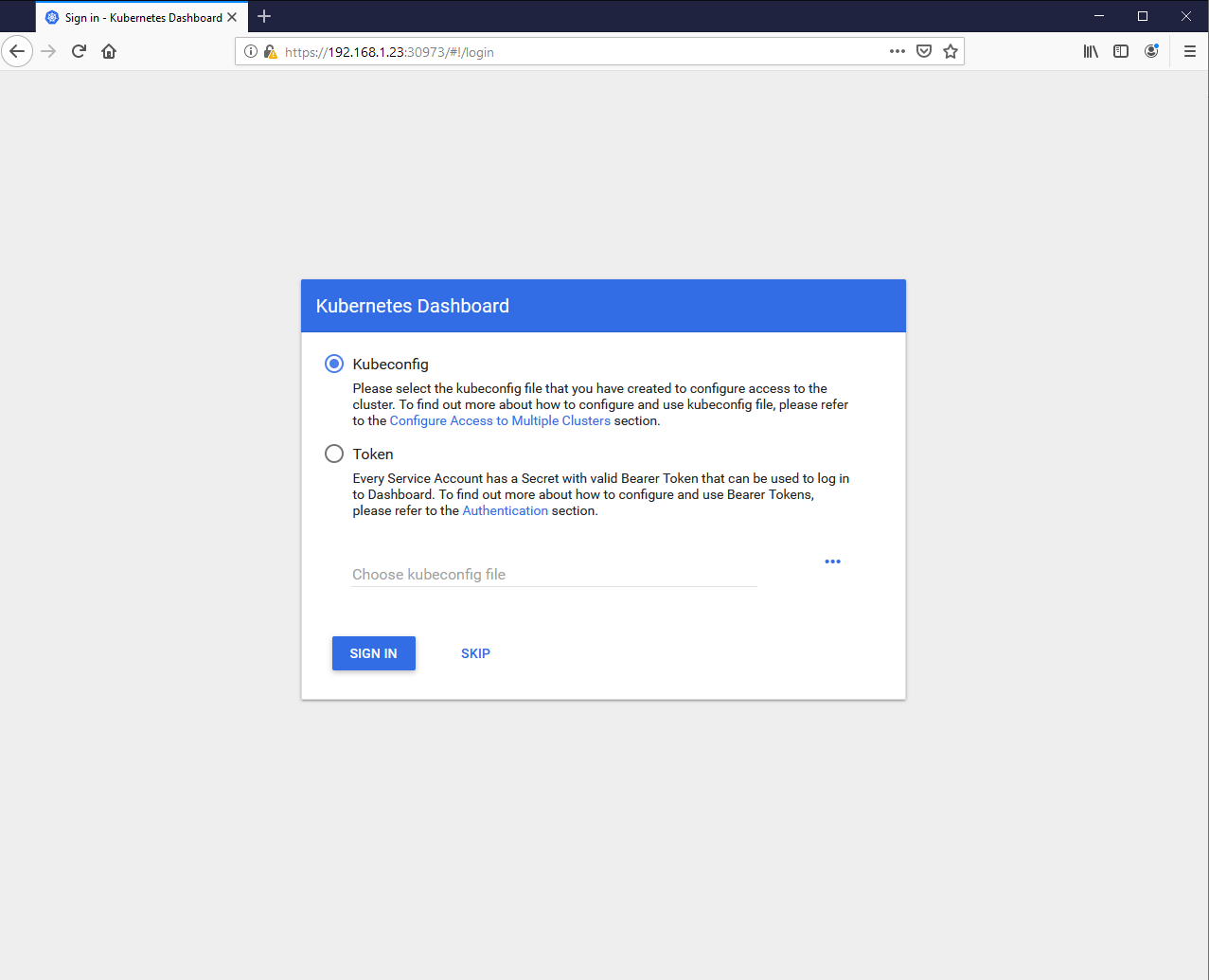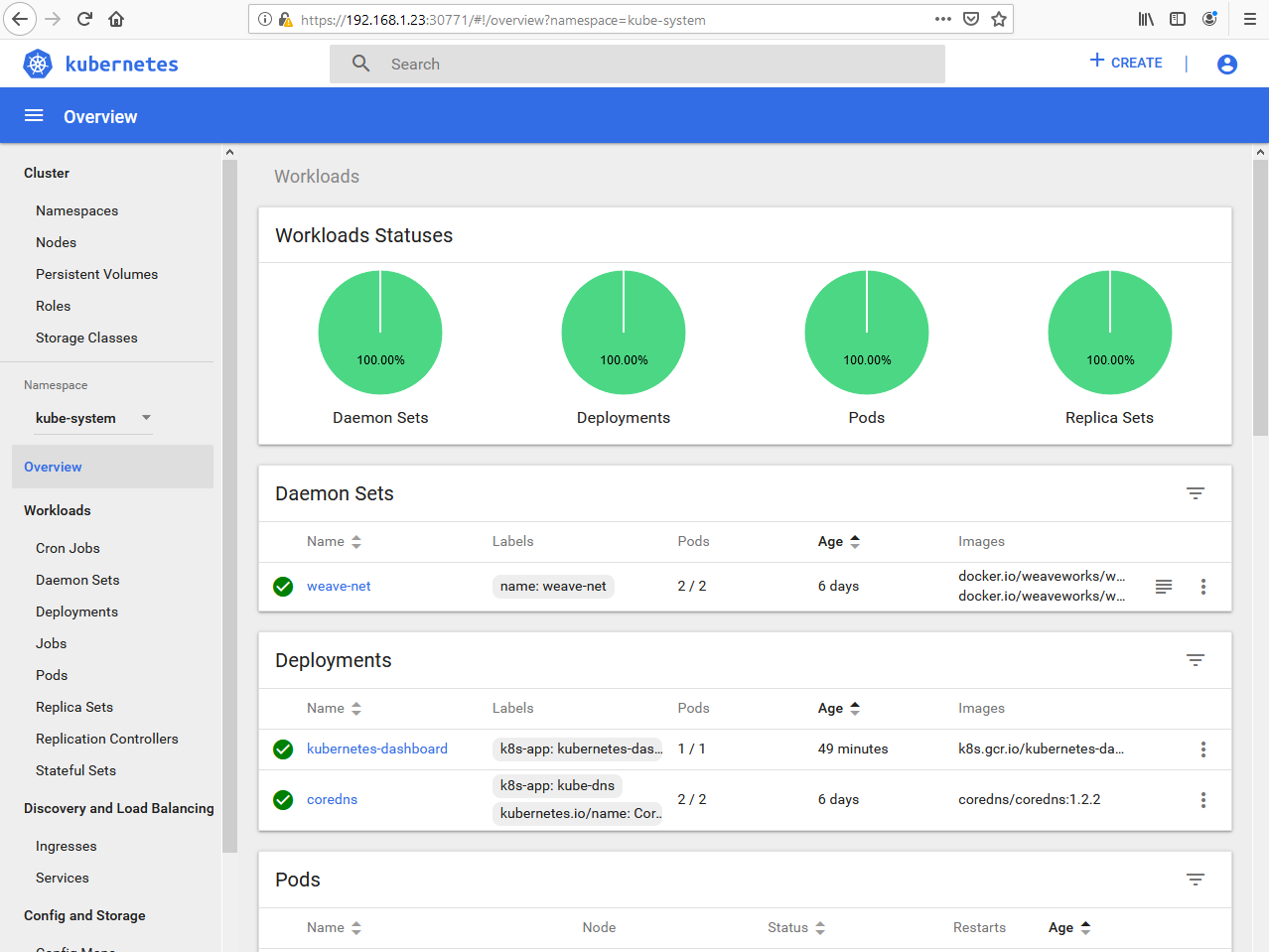Kubernetes Dashboard is a general purpose, web-based UI for Kubernetes clusters. It allows users to manage applications running in the cluster and troubleshoot them, as well as manage the cluster itself.
Deploy the dashboard cluster add-on:
$ kubectl apply -f https://raw.githubusercontent.com/kubernetes/dashboard/v1.10.1/src/deploy/recommended/kubernetes-dashboard.yaml
cat > dashboard-service.yaml <<EOF
kind: Service
apiVersion: v1
metadata:
labels:
k8s-app: kubernetes-dashboard
name: kubernetes-dashboard
namespace: kube-system
spec:
type: NodePort
ports:
- port: 443
targetPort: 8443
selector:
k8s-app: kubernetes-dashboard
EOF
kubectl apply -f ./dashboard-service.yaml
Verify the deployment
kubectl get deployment kubernetes-dashboard -n kube-system
NAME READY UP-TO-DATE AVAILABLE AGE
kubernetes-dashboard 1/1 1 1 19m
Verify the pod.
kubectl -n kube-system get pods -o wide
NAME READY STATUS RESTARTS AGE IP NODE NOMINATED NODE READINESS GATES
...
kubernetes-dashboard-57df4db6b-5mvtj 1/1 Running 0 20m 10.96.0.132 hadoop-slave4 <none> <none>
...
Verify the service and note down the port number 30771
kubectl get services kubernetes-dashboard -n kube-system
NAME TYPE CLUSTER-IP EXTERNAL-IP PORT(S) AGE
kubernetes-dashboard NodePort 10.96.0.7 <none> 443:30771/TCP 21m
Since kubernetes-dashboard exposed NodePort, we can visit the site through
https://192.168.1.18:30771
or
https://192.168.1.23:30771
After accept risks, you may get following result on screen,
kubectl create sa dashboard-admin -n kube-system
kubectl create clusterrolebinding dashboard-admin --clusterrole=cluster-admin --serviceaccount=kube-system:dashboard-admin
ADMIN_SECRET=$(kubectl get secrets -n kube-system | grep dashboard-admin | awk '{print $1}')
DASHBOARD_LOGIN_TOKEN=$(kubectl describe secret -n kube-system ${ADMIN_SECRET} | grep -E '^token' | awk '{print $2}')
echo ${DASHBOARD_LOGIN_TOKEN}
You can use generated token to access dashboard. Or you can create a kubeconfig.
LOADBALANCER_ADDRESS=192.168.1.24
{
kubectl config set-cluster kubernetes-the-hard-way \
--certificate-authority=ca.crt \
--embed-certs=true \
--server=https://${LOADBALANCER_ADDRESS}:6443 \
--kubeconfig=dashboard.kubeconfig
kubectl config set-credentials dashboard_user \
--token=${DASHBOARD_LOGIN_TOKEN} \
--kubeconfig=dashboard.kubeconfig
kubectl config set-context default \
--cluster=kubernetes-the-hard-way \
--user=dashboard_user \
--kubeconfig=dashboard.kubeconfig
kubectl config use-context default --kubeconfig=dashboard.kubeconfig
}
Results
dashboard.kubeconfig
Select the file in your browser,

